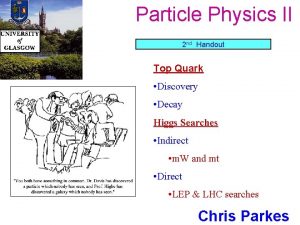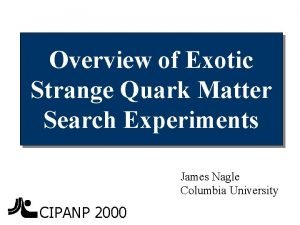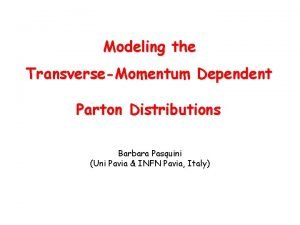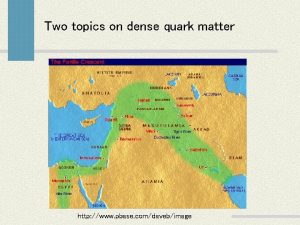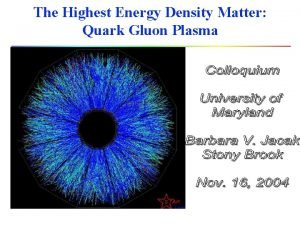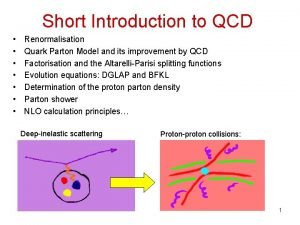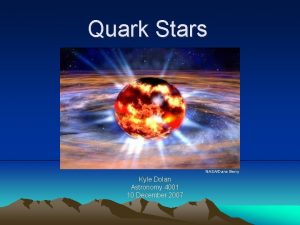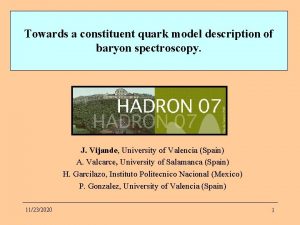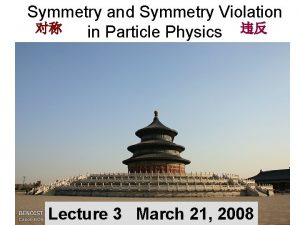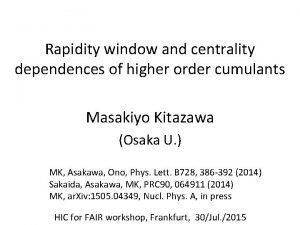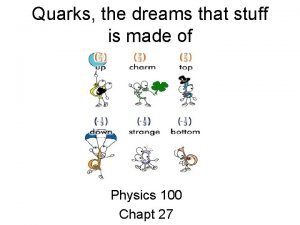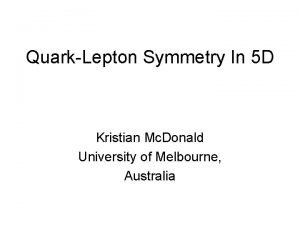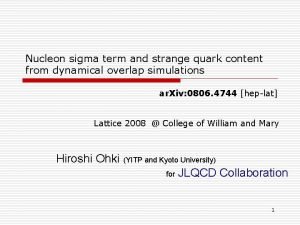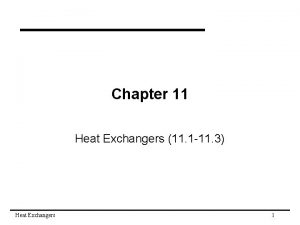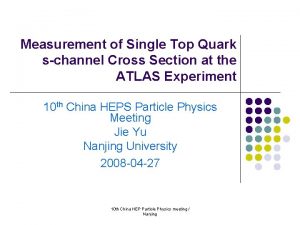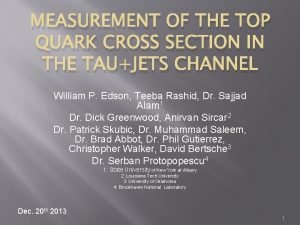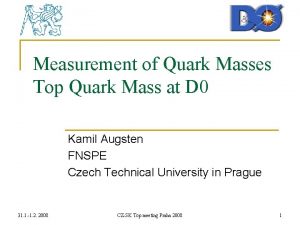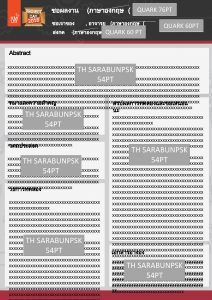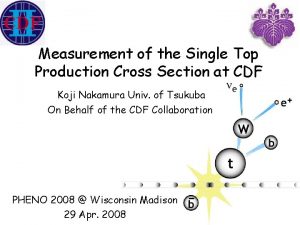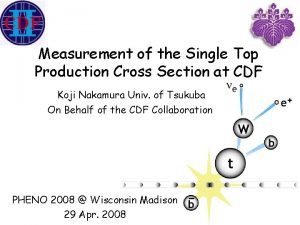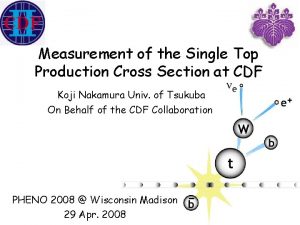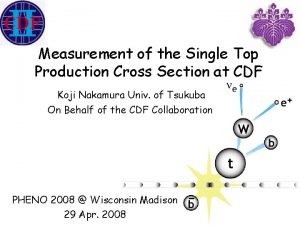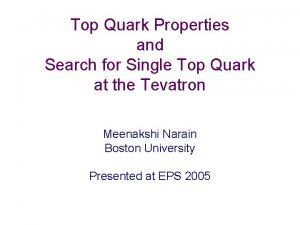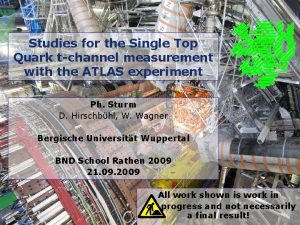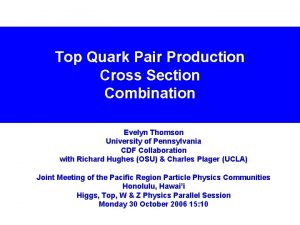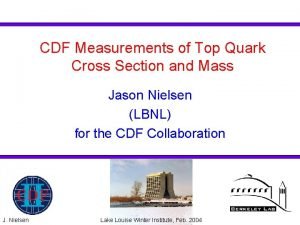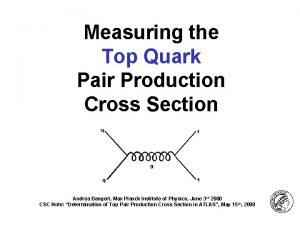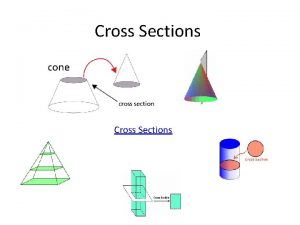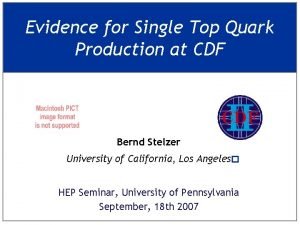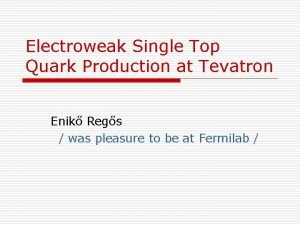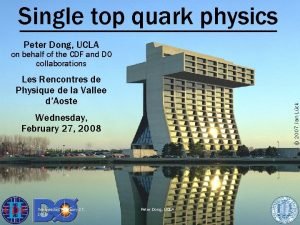Measurement of Single Top Quark schannel Cross Section






























- Slides: 30

Measurement of Single Top Quark s-channel Cross Section at the ATLAS Experiment 10 th China HEPS Particle Physics Meeting Jie Yu Nanjing University 2008 -04 -27 10 th China HEP Particle Physics meeting / Nanjing

Outlines n n Introduction S-channel cut analysis and results Multivariate analysis and results Summary 2/27/2021 10 th China HEP Particle Physics meeting / Nanjing 2

Introduction The reasons of doing single-top analysis: 1. a key particle in the quest for the origin of particle mass. 2. EW interaction of the top quark is sensitive to many types of new physics. 3. the only known way to directly measure CKM matrix element Vtb 4. an important background to many searches for new physics 5. …… 2/27/2021 10 th China HEP Particle Physics meeting / Nanjing 3

three different single top mechanisms in Standard Model: time Figue 1. (a) t-channel (b) W+t channel (c) s-channel q 2 ≤ 0, q 2 = M 2 W , q 2 ≥ (mt + mb)2. Where q is the four momentum of W boson 2/27/2021 10 th China HEP Particle Physics meeting / Nanjing 4

The main backgrounds l ttbar events Ø Ø l l l ttbar l+jets mode ttbar 2 l+jets mode (with one lepton lost) W/Z + jets di-boson ( like: WW lvjj ) QCD background ( like: pp bbbar) ØFor the lack of MC data, we are only using ttbar background till now! 2/27/2021 10 th China HEP Particle Physics meeting / Nanjing 5

Process cross section and decay mode (1) process: t-channel s-channel Wt channel σ(pb): 245 ± 27 10. 2 ± 0. 7 51 ± 9 ttbar 835 Decay mode and probability: t Wb ~100% W l v ~2/9 ( l = electron or muon) W τv ~1/9 (τ decays into muon 17. 8%, electron 17. 2%) W jj ~6/9 2/27/2021 10 th China HEP Particle Physics meeting / Nanjing 6

Process cross section and decay mode (2) a. t-channel: pp Wg tb¯q Wbb¯q l v b b¯q b. Wt channel: pp t. W WWb j j l v b c. S-channel: pp W* tb¯ Wbb¯ l v b b¯ Final state of the three single top channels : ü 2 or 3 jets, 1 or 2 b jet, 1 lepton, with missing energy Ø Preslection cuts Final state of the signal s-channel : ü 2 b jets, 1 lepton, with missing energy Ø s-channel selection cuts Final state of ttbar events: ttbar: pp ttbar W+ b W- b ¯ l v b j j b ¯ l+ v l- v¯bb¯ τ+ τ - v v ¯ b b¯ τv b j j b ¯ 2/27/2021 10 th China HEP Particle Physics meeting / Nanjing 7

Preselection cuts: l l l l Selection for three single top channels Step 0: Triggers , Passed e 25 i or e 60 or mu 20 i Step 1: One high Pt lepton at least, with electron pt larger than 25 Ge. V/c muon 20 Ge. V/c Step 2: Veto of any 2 nd lepton with pt larger than 10 Ge. V/c ΔR>0. 4 Step 3: at least 2 high pt jets, pt larger than 30 Ge. V/c Step 4: Veto on the 5 th jet with p. T(jet)>15 Ge. V/c Step 5: At least 1 btagged high pt jet above 30 Ge. V/c η less than 2. 5 Step 6: Missing Energy no less than 20 Ge. V 2/27/2021 10 th China HEP Particle Physics meeting / Nanjing 8

Strategy(1): s-channel selection cuts l l l Step 1: two b-tagged jets with p. T>30 Ge. V/c Step 2: Veto on any 3 rd Jet with p. T>15 Ge. V/c Step 3: Total Ht (p. T combined jets only): 80<Ht<220 Ge. V/c Step 4: Seperation between 2 btagged jets: 0. 5 <ΔR(b 1, b 2) < 4. 0 ; Step 5: Sum of missing Et and p. T of leptons: 60 <m. Et+p. T(e, u) < 130 Ge. V/c; 2/27/2021 10 th China HEP Particle Physics meeting / Nanjing 9

Total Ht m. Et+p. T(e, u) üWe may find out the separation of the variables is not that distinct ü Discriminant variables distributions corresponding to an integrated luminosity of 1 fb-1 2/27/2021 10 th China HEP Particle Physics meeting / Nanjing 10

The s-ch cut analysis results l l l l Processes s-channel s-ch (τ )l muon channel 2. 47± 0. 12% 0. 71± 0. 16% electron channel 1. 49± 0. 10% 0. 64± 0. 15% t-channel t-chan (τ )l 0. 22± 0. 04% 0. 04± 0. 04% 0. 14± 0. 03% 0. 00± 0. 00% 84 W+t channel W+t chan (τ )l 0. 10± 0. 03% 0. 00± 0. 00% 0. 08± 0. 03% 0. 00± 0. 00% 11 tt l+jets tt (τ )l+j tt e + e tt μ+μ tt μ+ e tt μ+τ tt e +τ tt τ+τ 0. 09± 0. 01% 0. 04± 0. 01% 0. 08± 0. 01% 0. 02± 0. 01% 0. 34± 0. 05% 0. 48± 0. 06% 0. 33± 0. 04% 0. 69± 0. 05% n. Evt to L= 1 fb-1 46 223 150 0. 54± 0. 05% 273 0. 24± 0. 04% S/B = 46/741 = 6. 2%, S/ √ S+B = 1. 64 Not good enough Search for improvement 2/27/2021 10 th China HEP Particle Physics meeting / Nanjing 11

Strategy (2): Multi. Variate Analysis MVA uses multi-variables as input and get an output which in the most of the cases obtain better separation Step 1: two b-tagged jets with p. T>30 Ge. V/c l Step 2: Veto on any 3 rd Jet with p. T>15 Ge. V/c l -------------------------------------l Using MVA Events selected by steps above the line will be used as MVA input l 2/27/2021 10 th China HEP Particle Physics meeting / Nanjing 12

Multi. Variate data Analysis l Methods in MVA ü ü ü ü ü 2/27/2021 Rectangular cut optimisation Likelihood estimator (PDE approach) Multidimensional likelihood estimator (PDE Range Search approach) Fisher discriminant HMatrix approach ( 2 estimator) Multilayer Perceptron Artificial Neural Network (three different implementations) Boosted Decision Trees Rule. Fit … 10 th China HEP Particle Physics meeting / Nanjing 13

Methods Criteria PDERS/ k. NN HMatri / Cuts Likelih ood No Single Best Perf orma nce no / linear correlations nonlinear correlations Training Spee d Rob ustn ess Response Overtraining Weak input variables Curse of dimensionality Clarity 2/27/2021 Fisher 10 th China HEP Particle Physics meeting / Nanjing MLP BDT Rule. Fit SVM 14

Projected Likelihood Estimator (PDE Approach) Combine probability density distributions to likelihood estimator Reference PDF’s Output is a likelihood ratio is an output of Likelihood for every single event, 1 (signal like) , 0 ( background like) Ø Assumes uncorrelated input variables 2/27/2021 10 th China HEP Particle Physics meeting / Nanjing 15

MVA methods output variables ( take Likelihood as an example ) l five main background processes ttbar lepton+jet, ttbar dilepton, ttbar τ+lepton, W+jets, t−channel define likelihood functions specific to suppress each background: yttbar/lepton+jets, yttbar/dilepton, yttbar/τ+lepton, y. W+jets, yt−channel l ØEvery event has such five MVA output value , and then we shall apply proper cuts on them 2/27/2021 10 th China HEP Particle Physics meeting / Nanjing 16

Note: each y. Lh(i ) use some of the variables as input Variables 2/27/2021 yttbar/lepton+jets, yttbar/dilepton, yttbar/τ+lepton, y. W+jets, yt−channel 10 th China HEP Particle Physics meeting / Nanjing 17

Cut value for each method: MVA method to suppress the Bkg: tt->l+jets, tt->l+l, tt->l+tau, W+jets, t-ch l --- Factory : --------------l --- Factory : Method: Cut value: Cut value: l --- Factory : ----------------------------------l --- Factory : Likelihood: +0. 538 +0. 523 +0. 525 +0. 539 +0. 525 l --- Factory : Likelihood. D: +0. 004 +0. 223 +0. 214 +0. 019 +0. 188 l --- Factory : Likelihood. PCA: +0. 592 +0. 525 +0. 519 +0. 600 +0. 576 l --- Factory : HMatrix: -0. 184 -0. 138 -0. 153 -0. 183 -0. 174 l --- Factory : Fisher: +0. 051 +0. 039 +0. 056 +0. 057 +0. 064 l --- Factory : MLP: -0. 242 -0. 135 -0. 194 -0. 001 -0. 179 l --- Factory : CFMlp. ANN: +0. 392 +0. 379 +0. 395 +0. 398 +0. 380 l --- Factory : TMlp. ANN: +0. 203 +0. 355 +0. 337 +0. 214 +0. 546 l --- Factory : BDT: -0. 069 -0. 115 -0. 131 -0. 081 -0. 093 l --- Factory : BDTD: -0. 141 -0. 131 -0. 072 -0. 120 -0. 105 l --- Factory : Rule. Fit: -0. 197 -0. 221 -0. 217 -0. 187 -0. 227 l --- Factory : ----------------------------------l --- Factory : which correspond to the working point: eff(signal) = 1 - eff(background) 2/27/2021 10 th China HEP Particle Physics meeting / Nanjing 18

Cut on no stack histgrams of TMlp. ANN method Cut here Signal events tend to be more likely in the right side of the figure 2/27/2021 10 th China HEP Particle Physics meeting / Nanjing 19

s-ch Vs tt l+jets Cut on stacked histgrams of BDT method s-ch Vs tt di-lep 2/27/2021 10 th China HEP Particle Physics meeting / Nanjing 20

MVA output cut results (1) Likelihood. D Likelihood. PCA HMatrix Fisher schcut s-channel 44. 7 40. 1 39. 4 41. 2 35. 8 46 t-channel 52. 4 36. 5 28. 6 30. 2 41. 3 84 W+t channel 9. 4 5. 0 7. 2 9. 4 10. 5 11 tt-->l+jets 174. 7 112. 3 93. 6 137. 3 223 tt-->di-lep 92. 0 67. 1 67. 9 55. 4 62. 4 150 tt-->l+tau 198. 1 141. 2 135. 7 119. 3 129. 5 273 all BKG 526. 6 364. 5 351. 7 307. 9 381. 0 741 S/B 8. 5% 11. 0% 11. 2% 13. 4% 9. 4% 6. 2% S/sqrt(S+B) 1. 87 1. 99 2. 21 1. 75 1. 64 channelclassifiers Number of events are normalized to L=1 fb-1 2/27/2021 10 th China HEP Particle Physics meeting / Nanjing see: MVA do bring some improvement 21

MVA output cut results (2) channelclassifiers BDTD MLP CFMlp. ANN TMlp. ANN Rule. Fit sch-cut s-channel 50. 3 46. 0 3. 7 40. 0 35. 0 46 t-channel 39. 7 15. 9 19. 0 9. 5 17. 0 31. 7 84 W+t channel 6. 1 6. 6 4. 4 3. 3 8. 2 11 tt-->l+jets 88. 9 64. 7 70. 2 15. 6 45. 2 104. 5 223 tt-->di-lep 48. 4 29. 6 35. 1 5. 5 23. 4 48. 4 150 tt-->l+tau 104. 5 75. 7 74. 1 23. 4 60. 1 97. 5 273 all BKG 287. 6 192. 5 205. 0 58. 4 149. 0 290. 3 741 S/B 17. 5% 23. 9% 17. 6% 6. 3% 26. 8% 12. 1% 6. 2% S/sqrt(S+B) 2. 74 2. 98 2. 32 0. 47 2. 91 1. 94 1. 64 Number of events are normalized to L=1 fb-1 2/27/2021 10 th China HEP Particle Physics meeting / Nanjing 22

TMVA cut efficiency for signal and background channelclassifiers Likelihood. D Likelihood. PCA HMatr ix Fish er schcut signal efficiency 1. 74% 1. 56% 1. 53% 1. 60% 1. 39% 1. 79% t-chan efficiency 0. 10% 0. 07% 0. 05% 0. 06% 0. 08% 0. 16% W-tchan efficiency 0. 07% 0. 03% 0. 05% 0. 07% 0. 08% tt-->l+jets efficiency 0. 06% 0. 04% 0. 03% 0. 05% 0. 08% tt-->di-lep efficiency 0. 23% 0. 17% 0. 14% 0. 15% 0. 37% tt-->l+tau efficiency 0. 39% 0. 28% 0. 27% 0. 24% 0. 26% 0. 54% channelclassifiers BDTD MLP CFMlp. ANN TMlp. ANN Rule. Fit signal efficiency 1. 95% 1. 79% 1. 40% 0. 14% 1. 55% 1. 36% t-chan efficiency 0. 08% 0. 03% 0. 04% 0. 02% 0. 03% 0. 06% W-tchan efficiency 0. 04% 0. 05% 0. 03% 0. 02% 0. 06% tt-->l+jets efficiency 0. 03% 0. 02% 0. 03% 0. 01% 0. 02% 0. 04% tt-->di-lep efficiency 0. 12% 0. 07% 0. 09% 0. 01% 0. 06% 0. 12% tt-->l+tau efficiency 0. 21% 0. 15% 0. 05% 0. 12% 0. 19% 2/27/2021 10 th China HEP Particle Physics meeting / Nanjing 23

Combine two or more MVA methods l l l l --- Factory : Inter-MVA overlap matrix (signal): --- Factory : ----------------------------------------------------------- Factory : Likelihood. D Like. PCA HMatrix Fisher MLP CFMlp. ANN TMlp. ANN BDTD Rule. Fit --- Factory : Likelihood: +1. 000 +0. 798 +0. 801 +0. 763 +0. 746 +0. 740 +0. 775 +0. 771 +0. 754 +0. 739 +0. 756 --- Factory : Likelihood. D: +0. 798 +1. 000 +0. 862 +0. 858 +0. 813 +0. 791 +0. 719 +0. 806 +0. 755 +0. 788 +0. 763 --- Factory : Likelihood. PCA: +0. 801 +0. 862 +1. 000 +0. 882 +0. 836 +0. 815 +0. 730 +0. 817 +0. 778 +0. 798 +0. 778 --- Factory : HMatrix: +0. 763 +0. 858 +0. 882 +1. 000 +0. 887 +0. 854 +0. 700 +0. 866 +0. 820 +0. 845 +0. 820 --- Factory : Fisher: +0. 746 +0. 813 +0. 836 +0. 887 +1. 000 +0. 867 +0. 699 +0. 882 +0. 829 +0. 863 +0. 818 --- Factory : MLP: +0. 740 +0. 791 +0. 815 +0. 854 +0. 867 +1. 000 +0. 647 +0. 899 +0. 873 +0. 900 +0. 853 --- Factory : CFMlp. ANN: +0. 775 +0. 719 +0. 730 +0. 700 +0. 699 +0. 647 +1. 000 +0. 680 +0. 649 +0. 634 +0. 643 --- Factory : TMlp. ANN: +0. 771 +0. 806 +0. 817 +0. 866 +0. 882 +0. 899 +0. 680 +1. 000 +0. 873 +0. 882 +0. 846 --- Factory : BDT: +0. 754 +0. 755 +0. 778 +0. 820 +0. 829 +0. 873 +0. 649 +0. 873 +1. 000 +0. 872 +0. 859 --- Factory : BDTD: +0. 739 +0. 788 +0. 798 +0. 845 +0. 863 +0. 900 +0. 634 +0. 882 +0. 872 +1. 000 +0. 845 --- Factory : Rule. Fit: +0. 756 +0. 763 +0. 778 +0. 820 +0. 818 +0. 853 +0. 643 +0. 846 +0. 859 +0. 845 +1. 000 ØIf two classifiers have similar performance, but significant non-overlapping classifications check if they can be combined ØThe combining job is kind of trivial: do cuts on different classifier output! 2/27/2021 10 th China HEP Particle Physics meeting / Nanjing 24

Summary u It is no doubt that top quark analysis can lead us to some new physics u MVA methods can positively improve the cut efficiency in our analysis u Now that real data is in the air, we couldn’t be too prepared 2/27/2021 10 th China HEP Particle Physics meeting / Nanjing 25

Thank you ! ! 2/27/2021 10 th China HEP Particle Physics meeting / Nanjing 26

Backup slides 2/27/2021 10 th China HEP Particle Physics meeting / Nanjing 27

Fisher Linear Discriminant Analysis (LDA) n Well known, simple and elegant classifier n LDA determines axis in the input variable hyperspace such that a projection of events onto this axis pushes signal and background as far away from each other as possible n Classifier computation couldn’t be simpler: “Fisher coefficients” F 0 centers the sample mean y. Fi of all NS + NB events at zero n Fisher coefficients given by: 2/27/2021 , where W is sum CS + CB Ø Fisher requires distinct sample means between signal and background Ø Optimal classifier for linearly correlated Gaussian-distributed variables 10 th China HEP Particle Physics meeting / Nanjing 28

Nonlinear Analysis: Artificial Neural Networks n Achieve nonlinear classifier response by “activating” output nodes using nonlinear weights n Call nodes “neurons” and arrange them in series: Feed-forward Multilayer Perceptron 1 input layer n 1 . . . Nvar discriminating input variables i . . . N k hidden layers 1 . . . j . . . 1 ouput layer 1 . . . 2 output classes (signal and background) Mk M 1 (“Activation” function) with: Weierstrass theorem: can approximate any continuous functions to arbitrary precision with a single hidden layer and an infinite number of neurons Three different Multi. Layer Perceptrons available in TMVA Adjust weights (=training) using “back-propagation”: For each training event compare received and desired MLP outputs {0, 1}: ε = d – r Correct weights, depending on ε and a “learning rate” η 2/27/2021 10 th China HEP Particle Physics meeting / Nanjing 29

Boosted Decision Trees (BDT) l A decision tree is a series of cuts that split sample set into ever smaller sets, leafs are assigned either S or B status ØLike this phase space is split into regions classified as signal or background u. Each split uses the variable that at this node gives the best separation u. Some variables may be used at several node, others may not be used at all 2/27/2021 10 th China HEP Particle Physics meeting / Nanjing 30
 Top quark decay
Top quark decay Particle wordle
Particle wordle Quarks
Quarks Quark names
Quark names Barbara pasquini
Barbara pasquini Quark gluon
Quark gluon Quark gluon
Quark gluon Quark parton model
Quark parton model Quark astronomy
Quark astronomy Quark gluon
Quark gluon Quark names
Quark names Constituent quark model
Constituent quark model A charm quark has a charge of approximately
A charm quark has a charge of approximately Dimsi sir
Dimsi sir Quark gluon plasma
Quark gluon plasma 6 types of quarks
6 types of quarks Quark lepton symmetry
Quark lepton symmetry Sigma quark composition
Sigma quark composition Quark matter 2022
Quark matter 2022 Von neumann architecture is sisd
Von neumann architecture is sisd Dataxin
Dataxin Multi channel multi phase example
Multi channel multi phase example Single pass cross flow heat exchanger
Single pass cross flow heat exchanger Tubular heat exchanger
Tubular heat exchanger Test cross and back cross
Test cross and back cross Test cross and back cross with example
Test cross and back cross with example Types of dominance genetics
Types of dominance genetics What is the difference between monohybrid and dihybrid
What is the difference between monohybrid and dihybrid In the cross, in the cross be my glory ever
In the cross, in the cross be my glory ever Balanced occlusion definition
Balanced occlusion definition Chapter 8 section 1 what are earthquakes
Chapter 8 section 1 what are earthquakes
